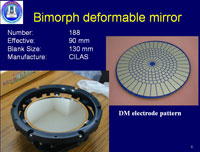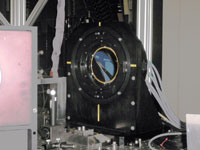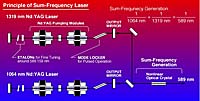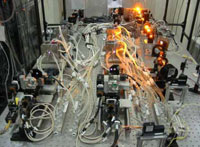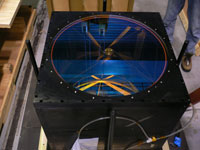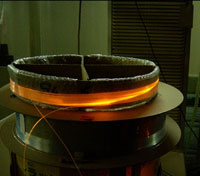Press Release
Subaru Telescope Improves its Eyesight by a Factor of Ten
November 20, 2006
On October 9, 2006 the Subaru telescope researchers used a new adaptive optics system to obtain an image of the Trapezium region of the Orion Nebula. A comparison of this new image with a first light image taken when the Subaru telescope first began observing in 1999 (Figure 1), shows a dramatic increase in contrast and detail in the higher-resolution image. With the new system in place, including a newly installed laser guide star system, to measure and correct for the effect of turbulence in real-time, Subaru's eyesight has been improved by a factor of ten, giving astronomers a clearer view of the universe.
Adaptive optics and laser guide star technology are important to astronomers because a ground-based telescope's ability to resolve spatial detail is limited by turbulence in the Earth's atmosphere. If the Subaru telescope were in space (without atmospheric interference) it could achieve an angular resolution of 0.06 arcseconds for light with a wavelength of 2 microns.
In practice, even with the excellent observing conditions on Mauna Kea, the typical resolution Subaru can obtain is 0.6 arcseconds because of the atmospheric turbulence that causes light traveling from stars and other objects to twinkle and blur. Fortunately, adaptive optics technology removes the twinkle and eliminates the blur. This allows astronomers to see greater detail in the objects they observe.
Subaru's adaptive optics development team has been working on upgrading its older 36-element adaptive optics system with an improved 188-element system for the past five years. At the same time, the team also developed and installed a new laser guide star system that allows astronomers to create an artificial star anywhere in the sky. They use light from the artificial star to measure the twinkle brought on by the atmosphere. That information is then used by the adaptive optics system to deform a special mirror that removes the twinkle and clarifies the view.
On October 12, 2006, researchers projected a laser beam into the sky to produce an artificial star in the sodium layer of Earth's atmosphere, at an altitude of about 90 kilometers. (Figure 2 and 3) Subaru's laser guide star system is the 4th system to be completed in the world for 8-10m telescopes, and its use of unique solid-state laser and optical fiber technology, both developed in Japan, represents a new and original contribution to the field.
Together, both systems open up a larger portion of the sky to observations with adaptive optics and allow Subaru to reach its theoretical performance limit (Figure 4).With the addition of these new systems, the Subaru telescope will enable astronomers to study objects that were previously unobservable, such as the detailed structure of faint distant galaxies and stellar populations of nearby galaxies. They will also be able to do more detailed imaging and spectroscopy of quasars and gamma-ray bursters.
The research and development of the new systems was supported by a grant from MEXT, the Japanese Ministry of Education, Culture, Sports, Science and Technology.
The following people at Subaru Telescope and the National Astronomical Observatory of Japan contributed to this research: Masanori Iye (Principal Investigator), Hideki Takami (Head of the Adaptive Optics Project), Yutaka Hayano (Leader of laser guide star system development), Makoto Watanabe, Masayuki Hattori, Yoshihiko Saito, Shin Oya, Michihiro Takami, Olivier Guyon, Yosuke Minowa, Stephen Colley, Michael Eldred, Mathew Dinkins, Taras Golota, Christophe Clergeon.
 |
Figure 1: An image of the trapezium region in the Orion Nebula with and without adaptive optics. The image on the right has a resolution of 0.6 arcseconds and was obtained with Subaru's CISCO camera in 1999 without the use of adaptive optics. The image on the left has a resolution of 0.06 arcseconds and was obtained in October 2006 using Subaru's IRCS camera and the new adaptive optics system. (Enlarge) |
 |
Figure 2: An exterior view of the Subaru telescope during tests of the new laser guide star system. The band of stars behind the telescope enclosure is the Milky Way. (30 second exposure). (Enlarge)
High res. version is here. |
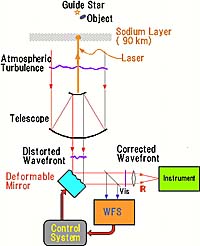 |
Figure 3: A schematic diagram of how the adaptive optics and laser guide star systems work. The adaptive optics system measures the distortion in the light from a guide star and then sends the light from the observing target to a deformable mirror whose surface shape is adjusted so that the distortions are removed from it upon reflection. (Enlarge) |
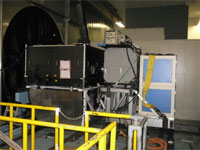 |
Figure 4: The 188 element adaptive optics system (the black box) and the
IRCS camera (the blue box) installed at one of Subaru's Nasmyth foci. Both
are about 2 meters wide. (Enlarge) |
Technical Notes
Note 1: See Solid State Laser for Subaru Laser Guide Star Adaptive Optics for more information on the 36-element system.
Note 2: The 188-element adaptive optics system allows Subaru to reach its diffraction limit, the theoretical limit of its resolving power determined by the size of its primary mirror (and the wavelength of light in question). Dr. Hideki Takami led the development and implementation of this system.The two main components of the AO system are the wavefront sensor that analyzes the light from the guide star, and the deformable mirror that corrects the light from the target object for any measured distortion in the light from the guide star. The wavefront sensor has a lenslet array (See Note 4) that divides the light from the guide star into 188 parts. A super-sensitive detector with avalanche photo diodes capable of measuring individual photons senses the brightness in each of these parts at high speed. The variation in brightness is used to determine the distortion in the wavefront of light from the guide star, and then to adjust the shape of the deformable mirror to counter the distortion. Such adjustments are made a thousand times a second. During the test observations on October 9, 2006, the adaptive optics system was able to remove atmospheric blurring and shrink an image of a star from 0.6 arcseconds to 0.06 arcseconds. (See Note 6).
Note 3: The laser guide star system was designed to make more of the sky available to the adaptive optics system. Dr. Yutaka Hayano led the development and production of the system. Subaru's laser guide star system uses a high-output laser (tuned to the sodium D2 line at 589 nanometers) to excite sodium atoms in the sodium layer of Earth's atmosphere, about 90 kilometers in altitude. The excited sodium atoms then release 589 nanometer photons and act as an artificial star for measuring the atmospheric distortion of light. With this instrument, any part of the sky overhead can be observed with the adaptive optics system. For example, distant galaxies that are far away on the sky from any bright star can now be studied in detail. The sodium laser for the system was developed in conjunction with researchers from the Solid State Optical Devices Research Unit of RIKEN led by Satoshi Wada. The laser is produced using a special optical crystal to combine a 1319 nanometer Nd:YAG laser with a 1064 nanometer Nd:YAG laser to produce a laser that matches the wavelength of the sodium D2 line exactly. (See Note 7) The 589 nanometer laser produced in the laser room is sent to the sky from a 50-cm-diameter laser launching telescope (See Note 8) attached to the top of the Subaru telescope. A new type of optical fiber developed in Japan called photonic crystal fiber (See Note 9) was used to send the high-power laser light from the laser room to the laser launching telescope with minimal loss.
Note 4: Light from the guide star is divided into 188 parts using an order-made 188-part lenslet array (right) and is sent to 188 avalanche photo diodes using 188 optical fibers. This critical component of the wavefront sensor required precise alignment.
Note 5: Wavefront errors are corrected using a bimorph-type piezo-electric deformable mirror 130-millimeters in diameter and only 2.0 millimeters thick. The 188 voltage-controlled segments move at high speed to change the deformable mirror's surface shape. (Piezo-electric material is a special ceramic that expands and contracts in response to a voltage applied to it.) The actuators applying the voltage to the deformable mirror have the same arrangement as the micro-lenses in the lenslet array.
Note 6: A 2.2-micron image of a star with the 188-element adaptive optics system on (left) and off (right). The 188-element system delivers shaper images compared to the 36-element system because it can correct more subtle errors. It can also improve image resolution under worse weather conditions, and can improve resolution even at optical wavelengths.
Note 7: The 589-nanometer laser is a sum-frequency laser created by mixing a 1319 nanometer Nd: YAG laser and 1064 nanometer Nd:YAG laser in a non-linear crystal. This laser was developed by RIKEN's Solid State Optical Device Research Unit, led by Dr. Satoshi Wada, and engineers at MegaOpto Co. Ltd, led by Kazuyuki Akagawa and others. By designing and fabricating a laser resonator with great precision and using the latest laser control technology and components such as non-linear optical crystals, the researchers were able to create a laser whose performance approaches the theoretical limit. The laser is tuned to the sodium D2 line with a six to seven digit precision (about 0.1 picometers), has a high output (4.7 watts) and is stable (less than 2% variability). See http://www.naoj.org/Pressrelease/2005/07/06/index.html for information from a July 2005 RIKEN press release on the first tests of the laser in Japan.
Note 8: The 50-centimeter-aperture laser-projection telescope sends the laser light into the sky in a collimated beam 50 centimeters in diameter. It is installed in the back of one of Subaru's secondary mirrors.
Note 9: Photonic crystal optical fibers are used to send the laser from the laser source to the launching telescope with minimum energy loss. These were also developed in Japan.
Note 10: Laser guide star technology is fundamental to the future of ground-based astronomical observations, and several groups around the world are carrying out its research and development. Subaru's laser guide star system is the 4th system to be completed on a telescope with a primary mirror 8 meters or larger. The use of unique Japanese solid-state laser and optical fiber technologies that provide stability and high performance makes the successful development of Subaru’s new laser guide star system a new and original contribution to the field.

